Executive Summary
In late 2022, OpenAI launched ChatGPT, an Artificial Intelligence (AI) driven, natural-language processing tool that offered the public the ability to conduct seemingly human conversations with a chatbot and generate a seemingly endless array of sophisticated content, including essays, emails, computer code, meal plans, fictional stories, and song lyrics, to name just a few. ChatGPT's introduction set off a wide-ranging public debate around both the transformative power of AI as well as the potential (and largely unpredictable) threats it may pose. While it could be decades before we know those answers, at the moment, professionals across every industry, including financial advice, are working to learn how they can leverage this new and remarkable tool to make their practices more efficient.
In this guest post, David Ortiz, the Managing Partner at the Financial Chef, shares his personal journey around how he gained a practical understanding of some advanced ChatGPT features, how he customized it to generate responses specifically tailored to the needs of financial advisors, and how he's implemented those and other AI-driven tools in his business.
With a background as a software executive, David was drawn to the potential of ChatGPT, prompting him to learn how he could use it to enhance his capabilities as an advisor. After delving into instructional content on YouTube University, he decided that the ideal use for AI in his practice was to improve the processes around client meetings, including generating summaries, extracting pertinent data, creating action items, and staying compliant.
By learning to design "custom GPTs" to create individual bots that could perform specific tasks, David created (and has made publicly available) an advisor-focused tool he calls the "Client Meeting Summarizer", which processes advisor/client meeting transcripts to gather, summarize, and organize key information from any meeting or call through various AI prompts. One of his most used prompts processes discovery meeting transcripts and allows users to gather, summarize, and organize key information, including demographic data, topics discussed, key points, action items, and next steps. Another is designed to extract information from data gathering and financial planning meeting transcripts for easy entry into financial planning software and also to summarize key points and action steps. A 3rd prompt reviews annual review meeting transcripts, capturing client quotes from key review areas, which can then be fed to a CRM. Finally, a 4th prompt reviews transcripts from the perspective of a compliance officer to ensure that David and his team adhere to regulatory standards and their own internal policies.
Additionally, AI tools have allowed David to transform what were once monologue-based planning meetings into interactive, engaging dialogues. By using a mindmap plugin, David and his team create high-level visuals that give clients a clear understanding of how their financial plans were constructed, how their specific issues are being addressed, and the value that David is delivering on an ongoing basis.
Ultimately, David has found that integrating AI into his practice has not only helped him become more efficient, but has also allowed him to ask better questions, gain a deeper understanding of his clients' needs, and hone his own listening skills. The net result has been higher client satisfaction and engagement, better-tailored plans that address each client's unique goals, and greater overall efficiency in his team's planning process. For David, the real promise of AI is in allowing financial advicers to foster deeper and more meaningful relationships with their clients, helping them be better (and more successful) at their craft!
In 1985, I found myself living in Venezuela, a foreign country, far away from the comforts and familiarity of my home. I was managing a restaurant and nightclub, a job that was as thrilling and vibrant as it was demanding and challenging. This was a period of my life that was filled with excitement, highlighted by the purchase of my first personal computer. This machine, a marvel of modern technology at the time, would become my constant companion and ignite a lifelong fascination with the world of technology.
My journey into the fascinating world of computers was a self-taught learning experience driven by a curiosity that was as insatiable as it was rewarding. I learned about macros and spreadsheet programming, skills that were not only intriguing but also highly practical. These skills allowed me to develop systems for theft control and efficiency improvements in my restaurant. It was like solving a complex mystery, finding the hidden patterns and secrets within the numbers and codes. This was the beginning of my love affair with technology, a relationship that would shape my career and personal life in ways I could never have imagined.
Fast forward to 1996; after a 5-year stint as a software executive, I decided to switch lanes and entered the world of financial advising. Even though this was a significant change into a new field for me, my longstanding affinity for technology was noticed in my new role. My colleagues recognized my skills and knowledge, and considered me the go-to person for technology-related matters. And when I discovered OpenAI's Generative Pretrained Transformer (GPT) language model technology, I was captivated by its potential. Finding ChatGPT was like stumbling upon a new case, a new mystery to unravel, a new challenge to overcome.
My curiosity, as always, led me on a quest to learn everything I could about OpenAI and ChatGPT. I turned to… where else? YouTube 'University'. There, I found a vast online resource of creators who guided me every step of the way. I spent countless hours watching videos, testing software, grasping the potential of this groundbreaking technology, and understanding how I could actually put AI to use in my practice. I was determined to harness its power to enhance my capabilities as an advisor. This was a new chapter in my lifelong relationship with technology, a chapter that promised to be as exciting and rewarding as the ones before.
AI As A Catalyst: Transforming Meeting Management From Frustration To Success
It dawned on me that I already had the ideal use case for AI staring me in the face: managing client communications. Our meeting process was inefficient, time-consuming, and sometimes even painful. This often led to delayed updates and work items getting to clients.
Our approach already involved creating audio recordings of all meetings and phone calls; these recordings could take 3 times as long to review as the actual meeting duration. In my learning journey through YouTube resources, I began hearing about 'prompt engineering' and realized that was the direction I needed to pursue to speed up the process of going through meetings and extracting client data. Prompt engineering is the process of designing and refining how questions are asked or how instructions are given to an AI tool to improve the quality of its output. The goal is to create prompts that are clear, concise, and aligned with the AI's understanding to elicit the best possible response that is most relevant to the user's needs. By carefully choosing specific words and providing context where necessary, AI tools can be steered to give more accurate, relevant, and useful answers and perform desired tasks more effectively.
My initial attempts at creating my own prompts were lackluster at best. To get better, I took online prompt-engineer classes on Skillshare, which significantly boosted my abilities. Enrico Schaeffer, YouTube creator and AI-focused attorney, taught me how professionals could use prompting and ChatGPT effectively. It was the first time I saw a related professional using AI for mission-critical work like drafting contracts and client matters. He convinced me that I could translate his work to our profession.
As I learned about prompt structures and roles, I realized that creating a great prompt was akin to developing an incredible recipe in the kitchen: It takes practice and skills to get the end product you are looking for. Trial and error are the bedrock for understanding how prompting works and how to stop your AI soufflé from falling!
In my AI education journey, I was initially captivated by the technology's potential and naively thought I could issue a single command for it to accomplish all tasks. ChatGPT doesn't work that way. In reality, the more detailed your input, the better your chances of obtaining the output you are looking for.
As I focused more on optimizing my results, I recognized the value of focused prompts designed in modular units rather than trying to extract all the data at one pass. This prompted me to analyze meetings and identify groups of key elements to extract. A thorough summary, crucial takeaways, action items with assigned parties, and a timestamped narrative of topics discussed were all vital components. So I looked to standardize the way I could apply prompts to my conversations.
I set out to perfect my AI prompting skills, which led me to learn of an incredible advancement by OpenAI called custom GPTs. This allowed us to create any number of specific bots that are trained and primed to perform the exact task we need. My goal was to use these tools to master the art of summarizing meetings.
In no time, I realized the potential of crafting my own AI realm where I could experiment with client meeting transcripts. Being able to use modular prompts to extract specific data and combine multiple prompts to create a comprehensive summary of client interactions was like having a full-range a la carte menu right before me.
Using custom GPTs, I created a ChatGPT-based playground called "Client Meeting Summarizer" centered around an advisor-focused bot that specifically processes advisor-client meeting transcripts. This allowed me to upload client transcripts and run various prompts against them to gain new insights. I was delighted and amazed at how easily I could create such a useful tool as my conversation bot. I uploaded my crafted prompts and now have an assistant to analyze any interaction I choose.
I was excited to share my playground with other advisors so they could experience the same thrill of seeing a meeting transcript come to life. However, I realized that some advisors might not have access to actual transcripts or may face compliance restrictions from their firms that prohibit them from uploading client meeting transcripts.
To address this, I developed another custom GPT tool, the "Client Dialog Generator", that generates realistic meeting transcripts for use in the Client Meeting Summarizer. My aim was to provide all advisors with tools to showcase the power of this AI application for advisors. So, for advisors who want to generate a sample transcript, one can be created that is tailored to particular preferences on any financial topic.
Here is an example that advisors may find helpful. Simply copy and paste the following prompt into the Client Dialog Generator prompt box to create a sample transcript:
Create a 15-minute transcript of an initial meeting with a client where the client gives extensive details of their KYC data describing their assets, income, expenses, goals, and objectives. Describe their hopes, fears, and wishes in retirement. Include timestamps throughout the dialogue.
I have focused Client Dialog Generator ChatGPT tool on understanding financial meetings and creating a realistic transcript that can be pasted into the Client Meeting Summarizer for advisors to practice their prompting skills or just learn how the tech works.
I cannot stress enough how important it is for advisors using AI tools to understand the concepts behind prompt engineering, even if they never write a single prompt themselves. I apply my understanding of prompting to shape the questions I ask in my meetings, knowing that AI will be paying close attention to our every word. I refer to it as guided output.
AI has bolstered my confidence that I am not only upholding my fiduciary responsibilities as a CFP professional but also embodying the very essence of being a Financial Advicer. AI has unveiled new dimensions in my practice, enhancing the services provided to clients and enriching the experiences of my staff and myself. Our understanding of the clients we serve has significantly improved. We now have access to more in-depth insights and clearer information that were previously undiscovered.
Transcript Transformation: Unlocking The Potential Of AI
Upon recognizing the value of using transcripts from client meetings to refine future engagements, the elegance of AI was unveiled. AI indefatigably analyzes these transcripts, a staple in our dialogue with clients. No matter the mode of interaction – be it virtual gatherings, recorded conversations, or in-person discussions – the information captured in transcripts yields an abundance of valuable insights.
Obtaining transcripts is straightforward and can be produced from an mp3 audio file, mp4 video file, or text file. In my case, RingCentral creates transcripts of live calls and archives them in a Google Drive folder for retrieval. For videoconference meetings, we use Zoom to record and export transcripts as TXT or CSV files. Effective transcripts include participant names and conversation timestamps, which many programs (including Fireflies.ai, which I discuss later) automatically apply. It is then as simple as uploading the captured transcript to ChatGPT, applying the desired prompt, and watching the magic happen. It is thrilling to watch as all my key client data appears and becomes my elixir leading to geek nirvana!
Every recorded word became a puzzle piece; with AI as our ally, we assembled them to reveal a bigger picture leading to better client interactions focusing on their data. This realization brought invaluable clarity and marked a turning point as we accessed previously elusive information. Understanding how using the right prompts with transcripts of our client meetings could channel AI's power opened up a world where every word held the potential to inform and enhance our work in unimaginable ways. In the following sections, I discuss 4 of my most used prompts.
Prompt 1 – Discovery Meeting Overview
Our obligations as financial advisors start with discovering and understanding the intricate details of our clients. In order to pull this key identifying data about our clients from a meeting transcript, I developed a prompt with the main goal of collecting client suitability data and Know Your Client (KYC) information in a clear and concise way.
One of the most important tools I use is the discovery meeting prompt. It is designed to engage with prospects who have attended a financial workshop and are now sitting for a strategy session in my mobile office. The prompt has been refined over time to capture the essence of our encounters, and is designed to work with a transcript with timestamps to navigate easily through the key points during the meeting's progression. This is an all-around prompt that can be used for any meeting. I provide the AI with the following text to do this (though advisors may choose to customize their prompt language depending on their needs and desired output):
Based on the transcript provided from a financial discovery meeting, your task is to extract and summarize the client's responses. This information should be organized into a columnar table. It should also offer an outline of the meeting timeline, a narrative of the meeting, and include a summary of the following: key points, action items, where we left it, client's status and next steps, advisor's status and next steps, and any other participants in the meeting.
I provided the following template to ChatGPT when I created the Client Meeting Summarizer so that it would understand how I wanted it to format the desired output:
This comprehensive format facilitates the accurate extraction and documentation of all relevant information from the meeting transcript, including KYC and suitability data. The result I get from the AI is formatted in an easy-to-read format, organizing the information in a way that is easy and convenient for me to access and refer to. It looks like this:
Prompt 2 – Data Gathering For Financial Planning Meeting
This prompt is designed to produce data that can be easily entered into our planning software. It is a prompt that can be run for any meeting that will summarize key points and organize data in a tabular format.
Based on the transcript provided from a financial planning meeting, provide the following information.
- Meeting Summary: Briefly summarize the main topics and decisions made during the meeting. Focus on areas related to financial goals, investment strategies, risk tolerance, and any changes in the client's financial situation.
- Data Extraction: Identify and list all the financial data mentioned in the meeting, and organize it in a table with 3 columns. In the 1st column, list the type of financial data extracted from the meeting (without including the actual data). In the 2nd column, note the corresponding area of financial planning it pertains to from the list below. In the 3rd column, include the corresponding data from the meeting. Include figures related to income, expenses, investments, debts, savings, insurance policies, and any other financial assets or liabilities. When creating the table, use the following categories:
- Income Analysis
- Expense Tracking
- Investment Strategy
- Debt Management
- Savings Goals
- Insurance Planning
- Retirement Planning
- Tax Planning
- Estate Planning
- Other (specify)
- Action Items and Recommendations: Based on the summarized discussion and the categorized financial data, identify any action items or recommendations for the client. This may include adjustments to investment portfolios, changes in savings strategies, updates to insurance coverage, or any other relevant financial advice.
- Next Steps and Follow-Up: Outline the next steps to be taken by either the financial advisor or the client. Include any follow-up meetings, additional information required, or deadlines for decision-making.
Below is a sample of the report that is generated for us:
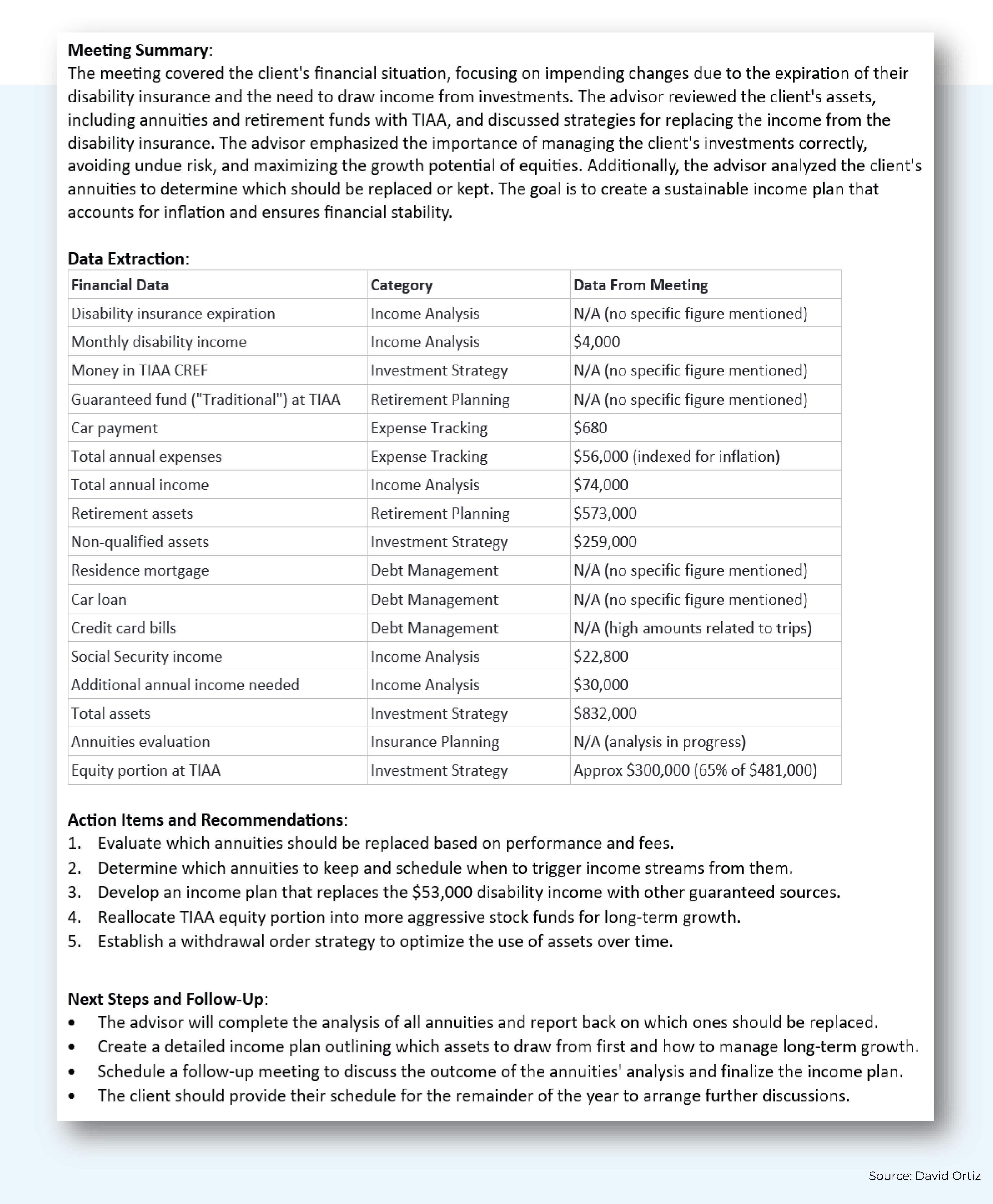
Prompt 3 – Annual Review Meeting Summary And Assessment Of Client Sentiment
When we conduct annual review meetings with clients, we review an updated risk tolerance, the client's financial goals, the annual portfolio performance report, asset allocation and rebalancing, fees and expenses, conflicts of interest, any changes to the client's financial situation, and any other updates. We address all these items consistently, to establish a process, a standard operating procedure for the annual review.
Then, we can run the prompt, extract, and document what occurred in the meeting, which then creates an AI-powered annual review meeting summary and populates the CRM. In addition to creating data tables as illustrated by the prompts used for discovery and data gathering meetings, I use a separate prompt to ask the AI to capture client quotes from each review area so I can document and understand the client's sentiment about their financial life.
Our detailed annual review meeting documentation prompt is shown below:
Based on the provided transcript of an annual review meeting, thoroughly capture the annual review discussion between the financial advisor and client. Focus on updated risk tolerance, financial goals, portfolio performance, asset allocation, rebalancing, fees, conflicts of interest, and any changes in the financial situation. Include direct quotes from the client for each area, noting the time of discussion. Record the meeting's narrative and compile a detailed table of KYC data, specifying areas, client quotes, and timestamps. This comprehensive approach ensures accurate and actionable records for CRM updating and future referencing.
The output looks something like this:
Prompt 4 – Wondering What Compliance Might Say
During my exploration of prompt engineering, I quickly recognized the value of using AI personas, which are a set of characteristics, styles, and/or behaviors assigned to the AI to guide how the AI presents its responses. With AI, it's just like Mama said, "Be whoever you want to be, just dream!" I pondered the idea of creating a compliance officer persona and having each client interaction assessed by a devoted AI compliance officer working alongside me.
This led me to design a prompt that assigned the AI a role as a "professional summarizer and Chief Compliance Officer of an RIA", instructing it to scrutinize our exchanges as a chief compliance officer examining them, with precise instructions on how to format the output.
You're a professional summarizer and the CCO of an RIA. Create a concise and comprehensive summary of the attached transcript to ensure we are following compliance guidelines in our client interactions and also to get the advisor's staff up to speed on action items from the meeting so they can better serve the client. Adhere to the following guidelines:
- From the perspective of the CCO, craft a detailed, thorough, and in-depth summary while maintaining clarity and conciseness.
- Incorporate main ideas and essential information, eliminating extraneous language and focusing on critical aspects.
- Rely strictly on the provided text without including external information.
- Format the summary in paragraph form for easy understanding, starting with a bullet point at the beginning of each paragraph. List each item in bullet format.
- Write in the first-person perspective, avoiding the use of things like "the speaker" or "the user". Instead, use the perspective of the speaker, e.g., "I".
- Bold key subject matter and indicate potential areas that may need expanded information using markdown.
- Conclude with an "Action Items Checklist".
Now, I have my personal compliance guide present at every meeting, providing valuable coaching afterward to ensure we remain on the right track by adhering to legal standards and internal policies. In addition to providing meeting summaries, it also itemizes critical action items I've committed to the client, ensuring that my firm meets our obligations and maintains compliance:
Financial Plan Deliverables Reimagined By AI
The enduring issue of engaging clients in the planning process troubles many advisors, myself included. Our approach to this challenge was to present plans after analyzing client data, but it lacked interactivity. I aimed to transform planning meetings into captivating dialogues that involved active discussion with clients instead of monologues delivered by me lecturing the client on their plan. Despite eMoney's attempt to simplify with a "one-page plan" deliverable, flexibility was missing.
However, by creating a narrative for plans with ChatGPT and utilizing the Whimsical Mindmap plugin to generate output, we have developed engaging mindmap materials that encourage clients to participate in meetings. My planning assistant and I start this process by recording a thorough 10-minute conversation reviewing the client's financial plan and timeline – from their initial circumstances upon becoming a client to the safety measures and tax benefits implemented since engaging with our firm. We would then use the narrative to identify potential areas for further discussion with clients during meetings.
We used these mindmaps as high-level narrative outlines to help direct conversations with clients during presentations while ensuring comprehensive coverage of the financial planning topics we needed to discuss. I also use this initial mindmap outline to craft more detailed maps of other outline topics by prompting the AI to extract relevant points pertinent to each mindmap focus. These maps exemplify how data can be pulled from the transcript for different sets of topics by running various prompts to summarize key takeaways, generate talking points, and experiment with various methods of extracting data.
The beauty of these MindMaps is their ability to distill extensive financial plans into concise visuals. Clients now have a visually impactful and easily digestible agenda that gives them a clear understanding of our strategies and the work we've done for them. Our standard operating procedure has evolved, with soaring client enthusiasm in response to this approach.
Another mindmap strategy helps clients understand how their financial plan was constructed and connects areas of CFP Board practice standards with the specific issues faced by the client. This helps to demonstrate how I fulfill my obligation as a CFP practitioner.
Finally, we also create a mindmap to complement the plan discussion with specific strategies and intended outcomes.
These maps not only serve as a reference for clients but also as a tool for discussing different plan sections and managing revisions. This newfound clarity has revolutionized how clients perceive their financial plans, ensuring better interactions and future success.
We found that this mindmap approach not only improved our overall advice engagement strategies, but also guided our own process to create the plan and prepare the meeting!
The AI Craft: Building A Toolkit For The Modern Advisor
In the ever-changing landscape of technology, my toolkit has evolved dramatically. When I first ventured into DIY AI, my goal was to craft a system that could effortlessly manage my hectic professional life – a life filled with meetings, phone calls, financial strategizing, and client engagement. These are the technological instruments that have become integral to my professional persona.
Over recent months, many software developers have woven AI into their products, boosting their functionality. My exploration has revealed a diverse array of components and instruments involved in this process. Some are essential, capturing the essence of data, while others are transformative, molding that data into desired outcomes. In the last year, I've come to rely on 2 primary tools – in conjunction with ChatGPT – as the cornerstone of AI in my dealings: RingCentral for my telephony needs and Zoom for virtual meetings.
Another noteworthy innovation is Fireflies.ai. This tool has evolved so significantly that it now stands out as the definitive tool for documenting client conversations, bridging both the recording and transformative processing by integrating with Zoom. Once an interaction is recorded, it's the transformative features of the Fireflies software that refine the original recording into a sleek end product – akin to watching a soufflé rise with perfection!
Fireflies grants users access to sophisticated AI tools (including ready-to-use, customizable AI prompts) that simplify the analysis of client communications, all without requiring any technical expertise. For financial advisors, its true strength lies in its ability to connect the advisor to all of their client interactions. It natively integrates with RingCentral, effortlessly processes phone calls, and automatically joins Zoom meetings while supporting Microsoft Teams and Google Meetings. Recordings of meetings can be imported into Fireflies as MP3, MP4, or WAV files for transcription by simply dragging and dropping files into the software interface. Upon discovering this feature, I eagerly uploaded old recorded files for Fireflies to work its magic.
Once Fireflies records a meeting, it offers an interface that can dispatch an email upon request. For Zoom sessions, the email includes an attachment of the video and a dynamic transcript for convenient referencing. Fireflies stands out with its fully customizable AI panel, enabling users to create subtasks and compile multiple prompts from recorded discussions.
The platform's extensive integration capabilities are another strong point. Beyond exporting files into RingCentral and Zoom, it can also export meeting files to Google Docs or route them to OneDrive or Box for archiving. The introduction of Fireflies' native apps further enhances its functionality, automating meeting-related actions like posing questions and tailoring notes.
For advisors eager to delve into a robust system, I recommend exploring Fireflies.ai. By becoming familiar with its features, tailoring prompts and automating processes can effortlessly become part of a dynamic AI routine.
AI-Enhanced Client Engagement
Up to this point, I've explored the integration of AI into our practice. I'd now like to share the profound changes in my thought process and communication since embarking on this AI journey. AI's ability to distill data from conversations sparked a reevaluation of the questioning techniques I use with clients during meetings to streamline data collection.
In the pre-AI days, capturing the details of questions that arose organically during client discussions meant manually recording every detail with great care. Now, we've crafted questionnaire templates for our meetings to serve as comprehensive checklists that ensure we capture all the necessary information. The advantages, however, go much further. My grasp of my clients' needs has deepened significantly, as AI helps surface details from meetings that I might have missed before. This has honed my listening skills, tuning me into the nuanced ways that clients express themselves and how they communicate what's important to them, leading to a more profound understanding of who my clients are and better-tailored plans to meet their unique objectives.
Moreover, AI has prompted us to innovate our financial plan delivery process. We leverage both our clients' transcripts and ChatGPT's insightful analyses when guiding clients through their financial strategies. Crucially, this knowledge is no longer confined to my own mind; it's shared across my entire team.
Our workflow now involves my paraplanner serving as my assistant, skilled in eliciting and interpreting client communications and using AI technology to analyze and distill key information. I encourage him to adopt the perspective of a small bird on my shoulder during meetings, ensuring he has a holistic view of the client's situation, just like I do, which leads to enhanced outcomes for our clients. Our whole team is committed to each client's success.
This method also improves client service by creating a "where we left off" summary that captures everyone's expectations following each interaction, providing an overview of the conversation's progression, how it evolved through the meeting, any areas of concern, and where in the conversation the meeting was concluded. The prompt we use provides an alternative perspective on consolidated data, allowing individuals to understand everyone's commitments and expectations. The team primarily uses this specific prompt to stay informed about meeting proceedings.
Client satisfaction has soared as we've been able to deliver swifter, more thorough solutions. For us, as financial advicers, the real magic of AI hasn't been about surpassing market performance or dissecting SEC filings; it's been about how we've been able to partner more closely with our clients, gaining insights into their lives in ways that were previously unfathomable.
As fiduciaries and advisors, we've reached a newfound closeness with our clients, continuously nurturing an aspect of our relationship that we deeply cherish. And with today's cutting-edge AI tools, we've been able to enter a realm brimming with boundless opportunities and untapped possibilities!


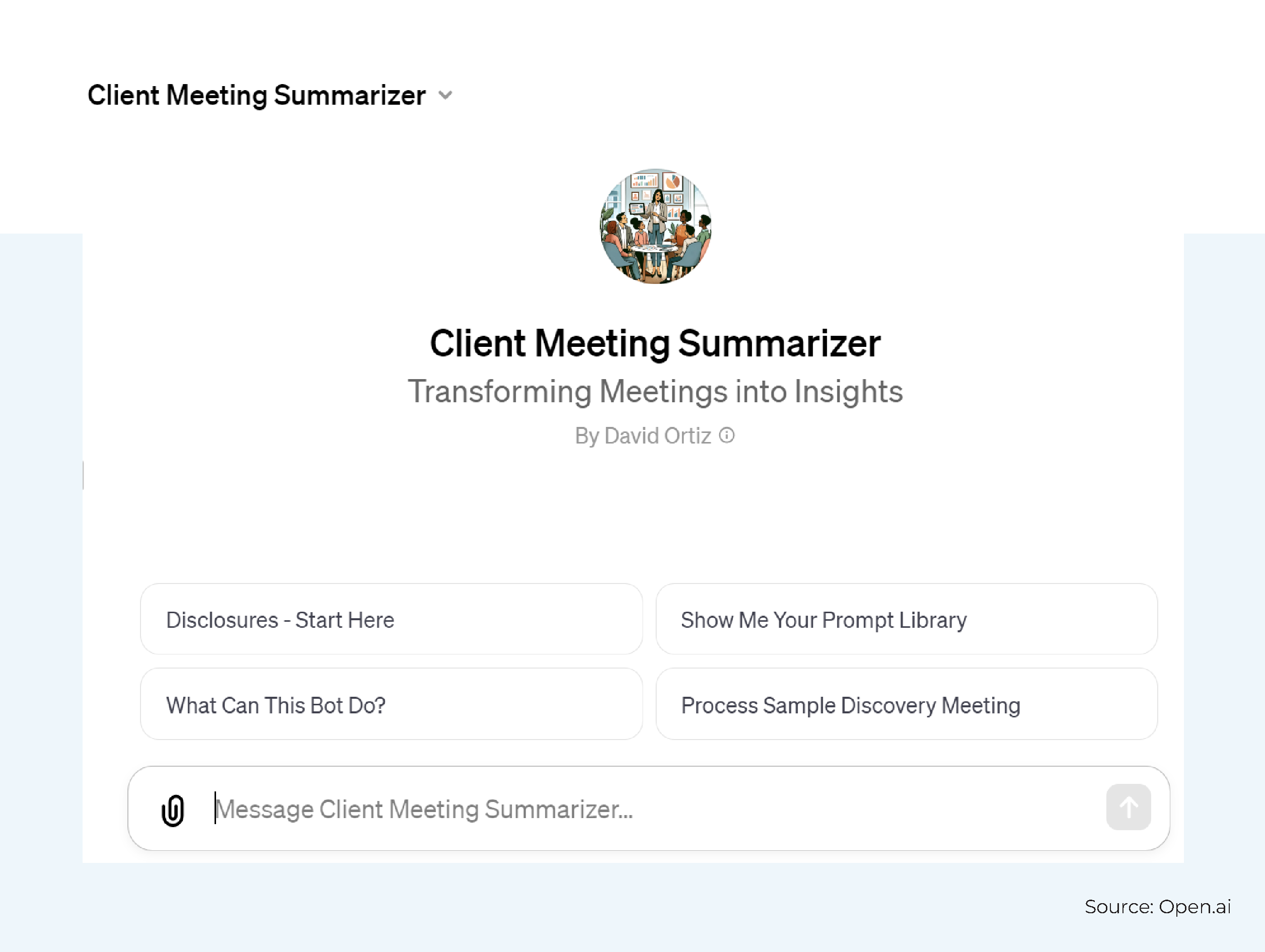
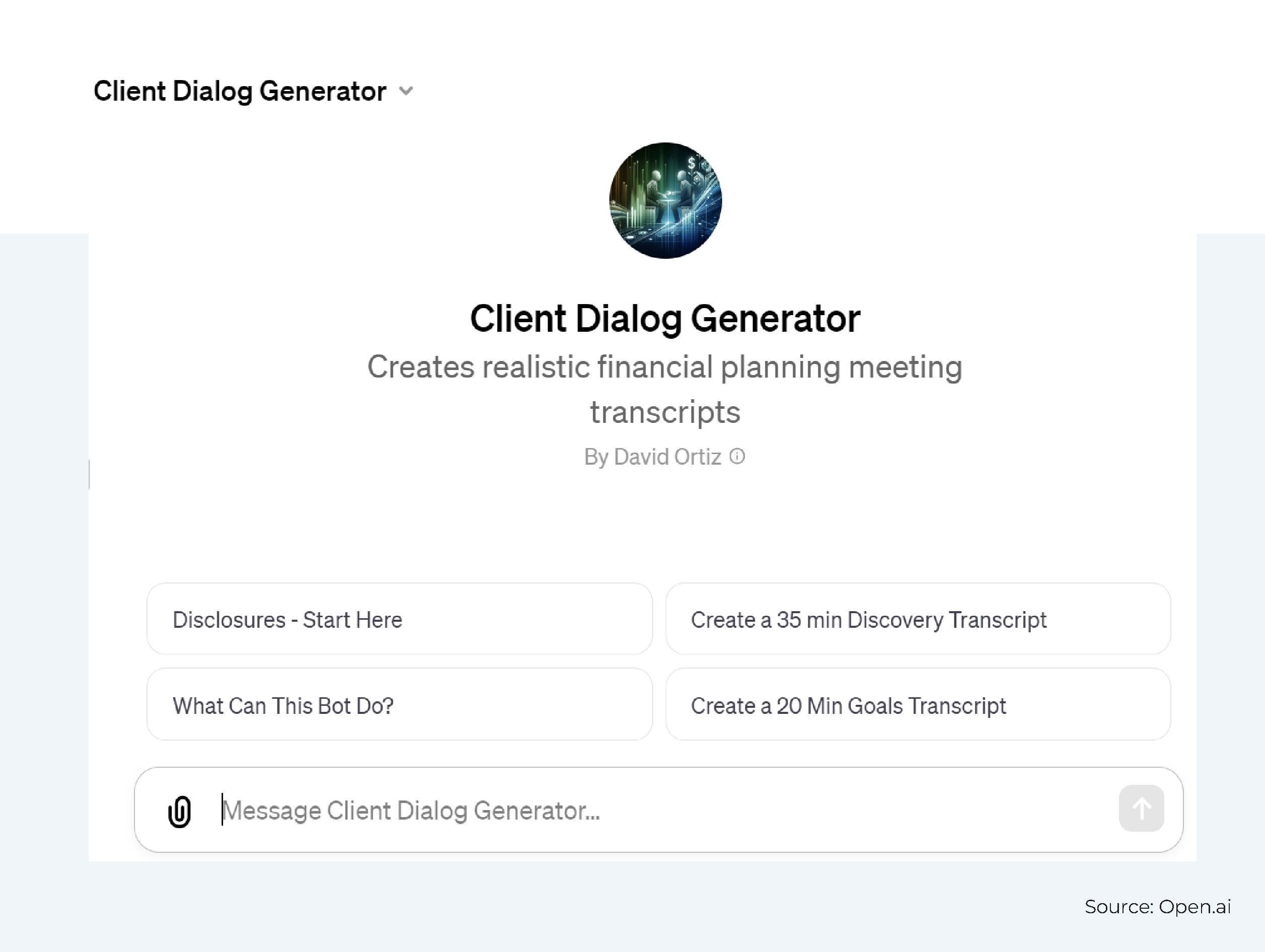

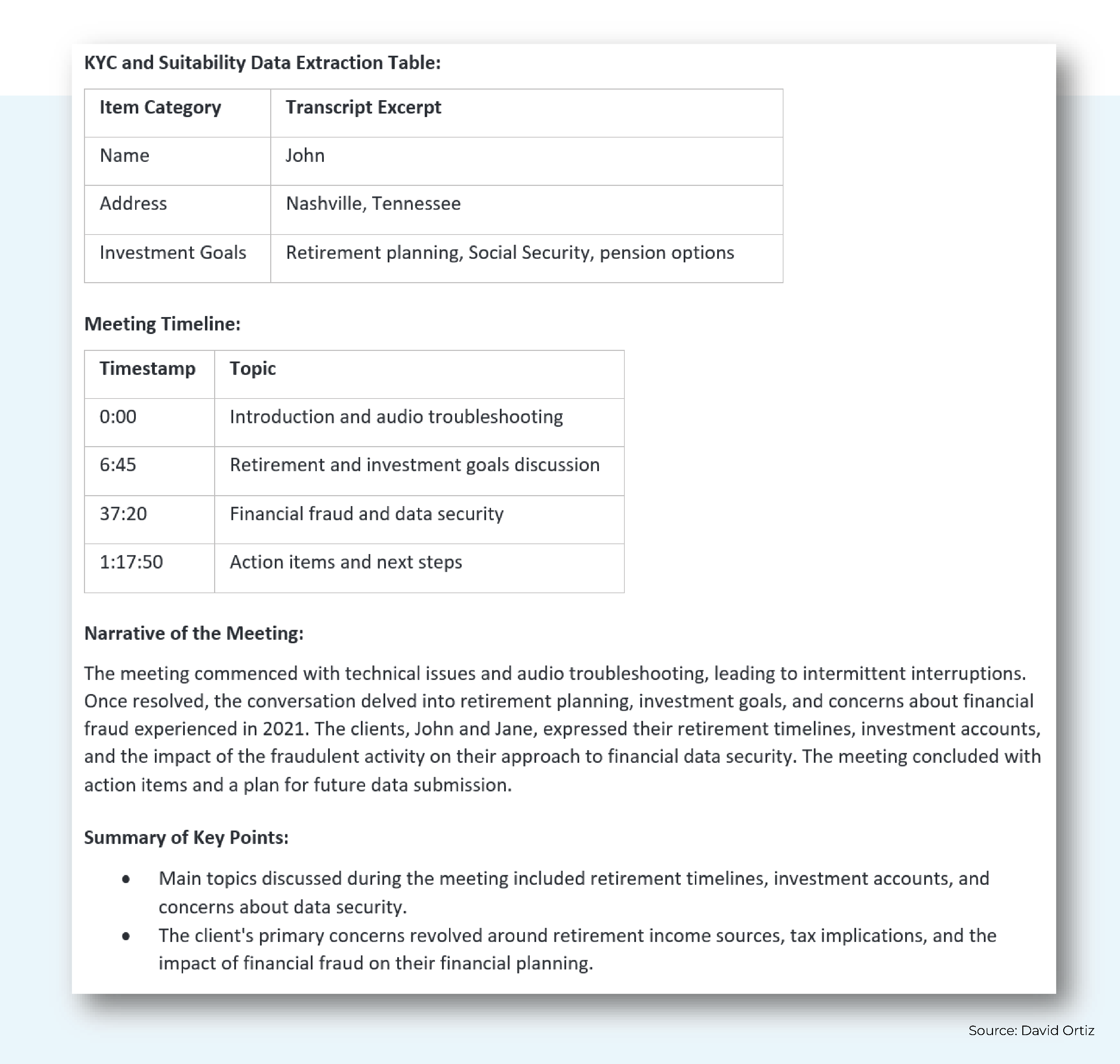
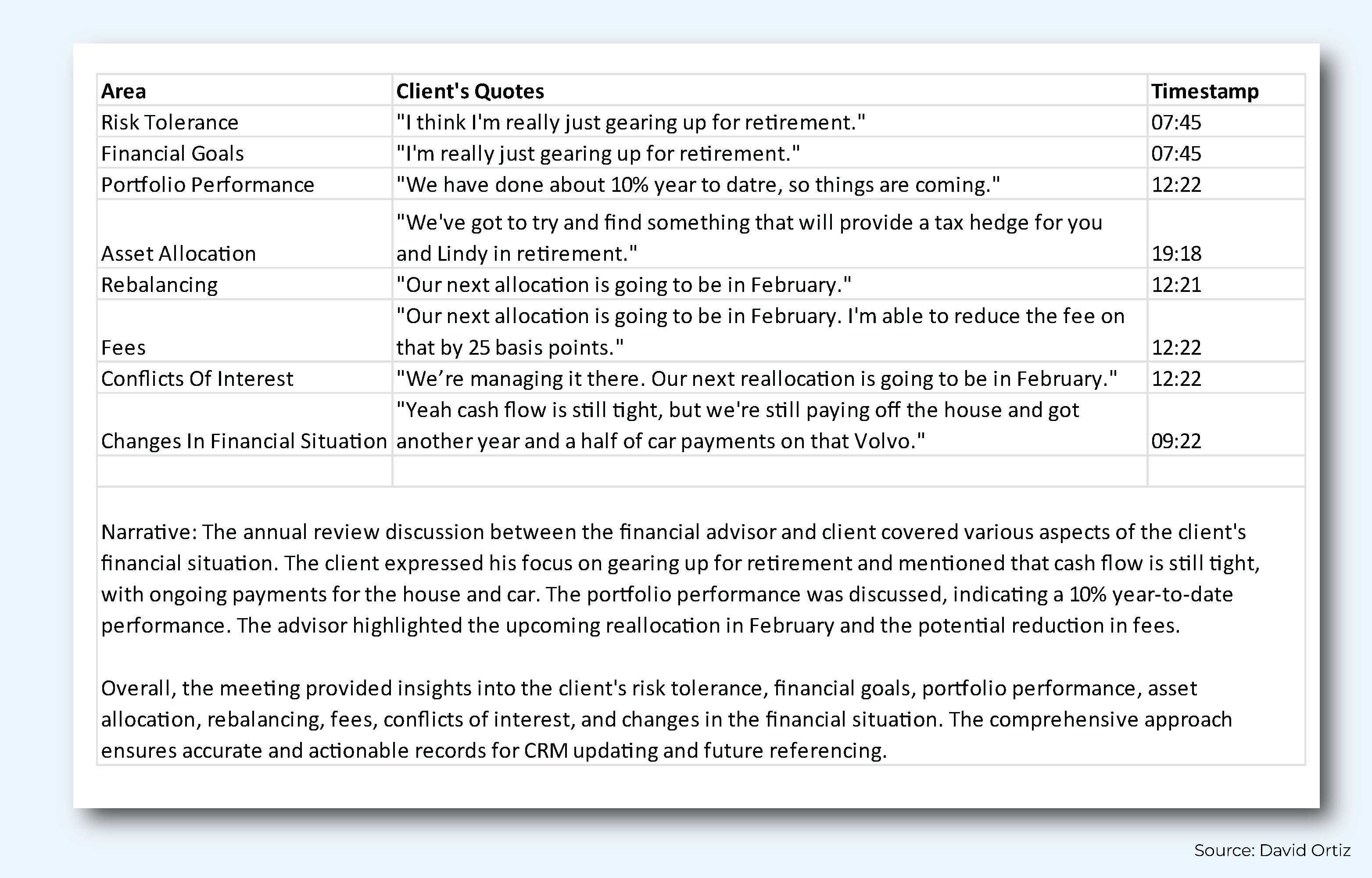

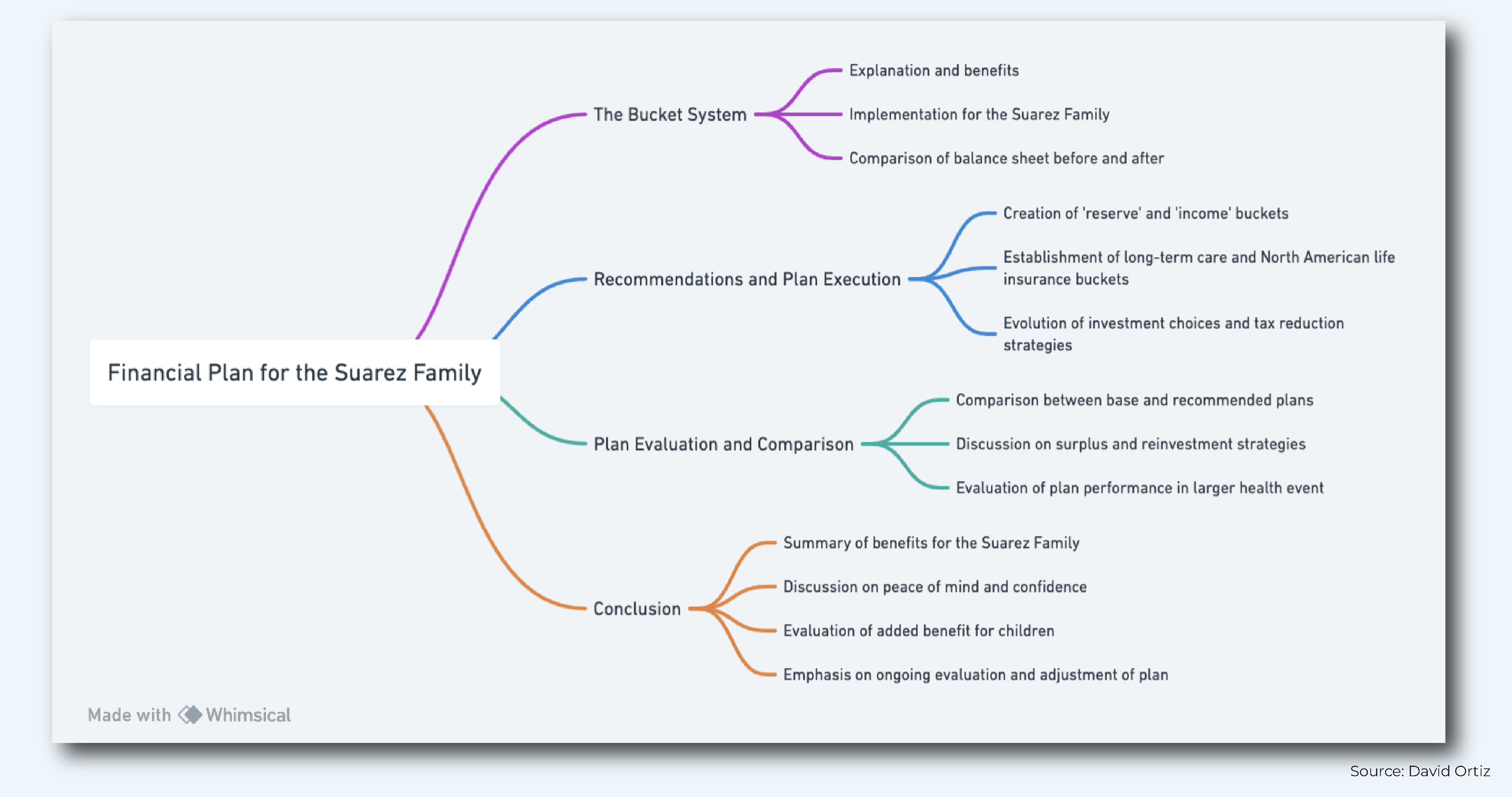
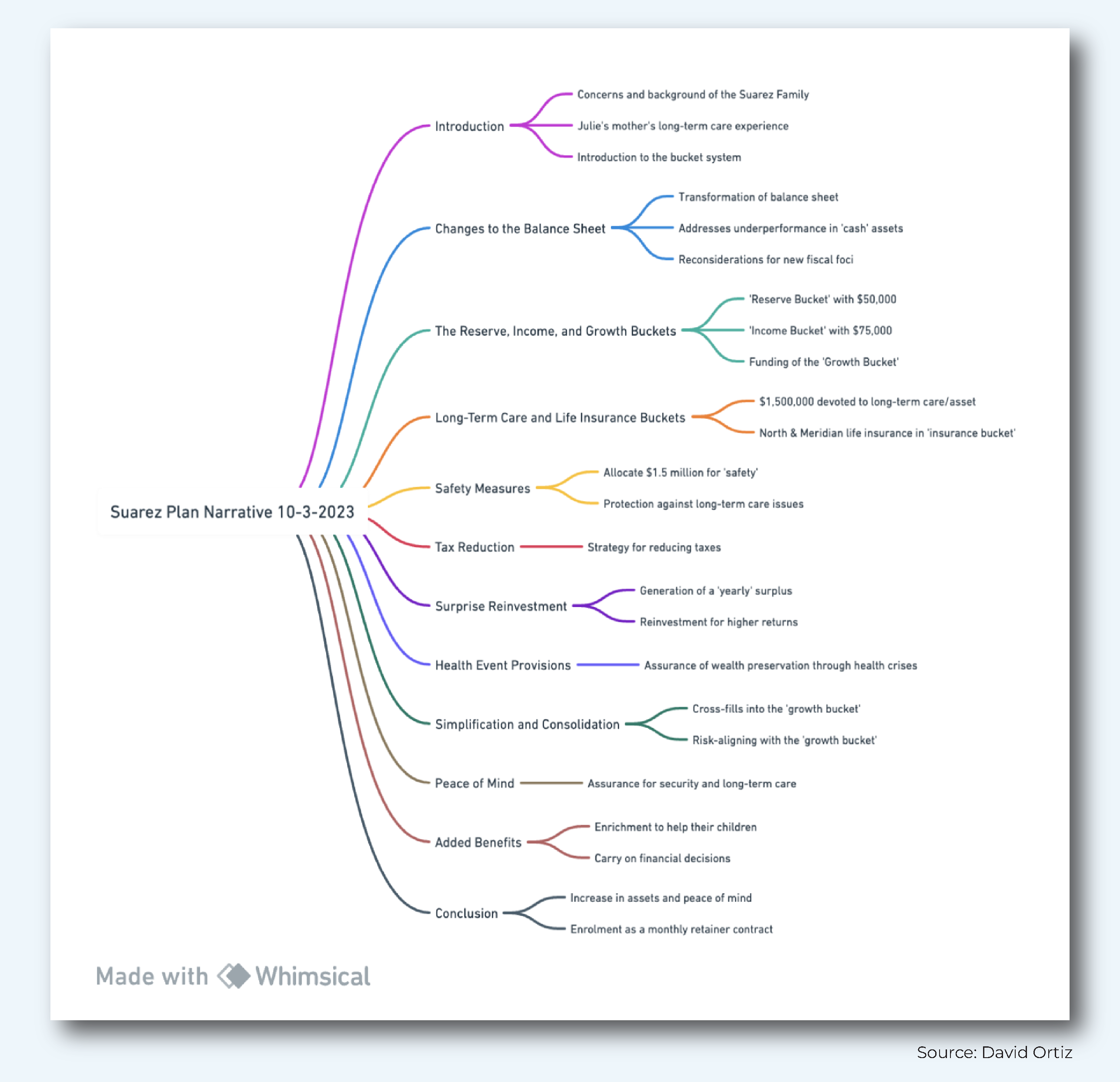
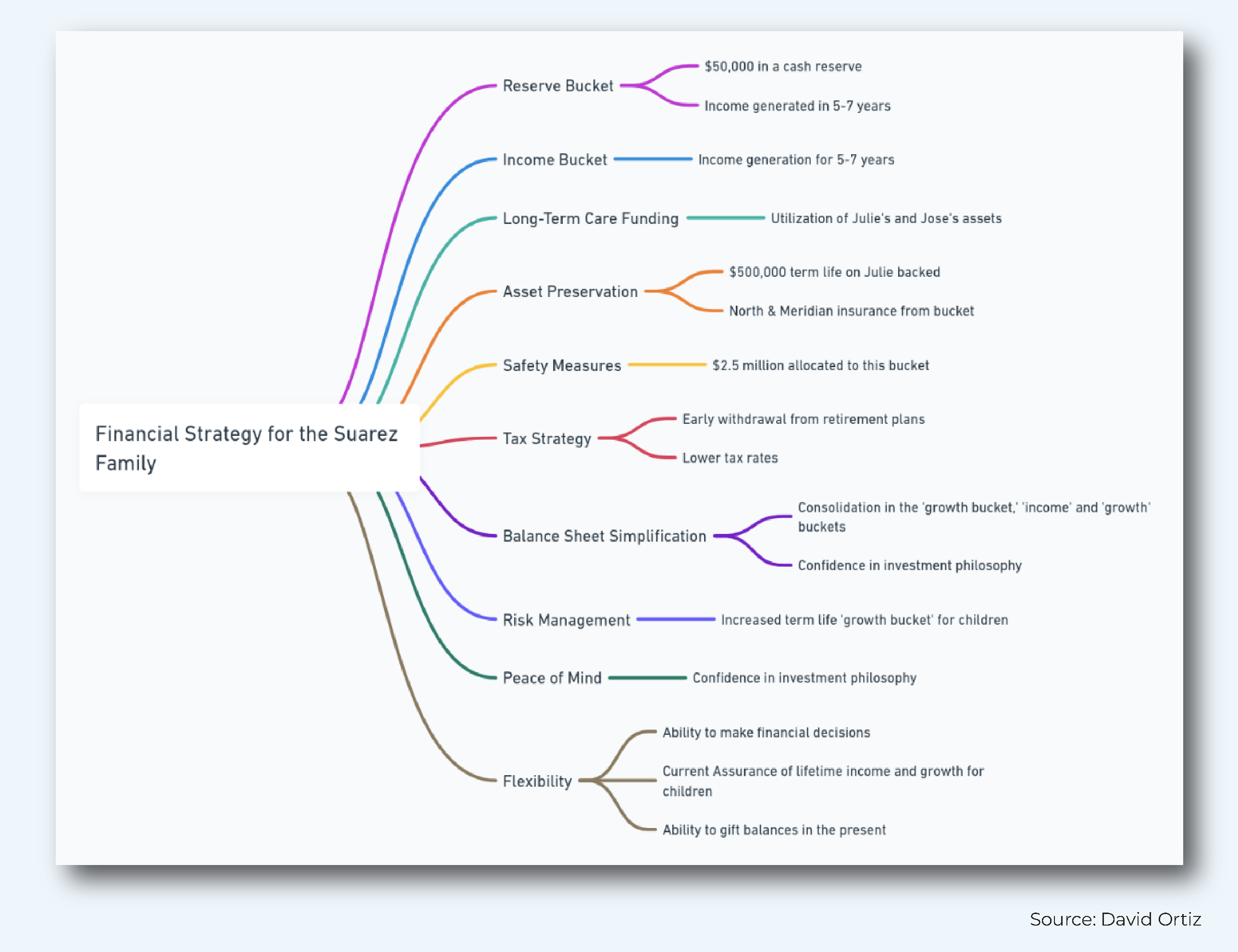



Leave a Reply